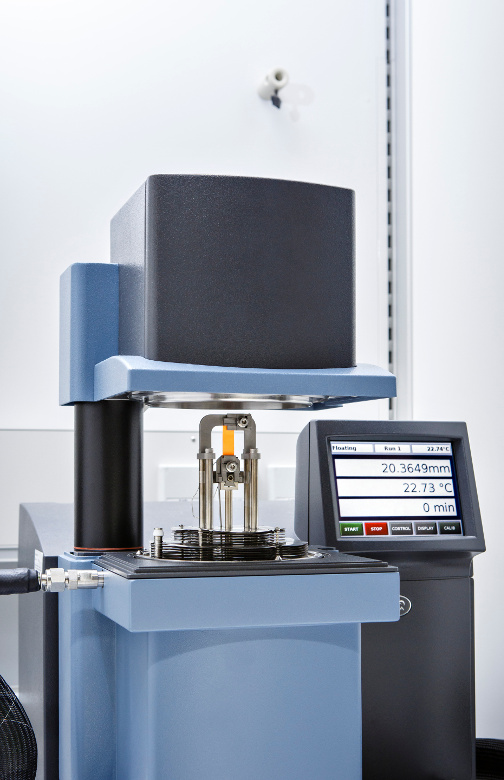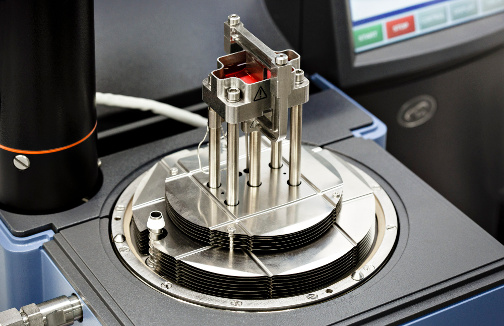
Dynamic-Mechanical Analysis

The dynamic-mechanical analysis (DMA) or dynamic mechanical thermal analysis (DMTA) allows a comprehensive determination of mechanical properties of polymeric materials at different temperatures and frequencies. A special feature of the dynamic-mechanical analysis is the capability to examine the mechanical properties of polymers under the influence of humidity, solvents and other organic liquids. The method is applicable to polymeric solids, melts, solutions and dispersions and can be used to examine chemical changes in the material, for example, cross linking/curing of resins or thermal degradation.
Polymers are viscoelastic materials, meaning they show both viscous and elastic properties. The viscoelastic behavior depends on the temperature and frequency or shear rate during the measurement. With temperature dependent measurements at different frequencies, a “master curve” can be compiled by utilizing the frequency-temperature equivalence. Under isothermal conditions creep tests or stress relaxation experiments can be conducted.
From the changes in rheological and mechanical properties, parameters such as the glass transition temperature, crystallization temperature, melting point and other transitions can be determined. For this, temperature dependent experiments are conducted by one or more frequencies. Time dependent processes, such as crystallization, cross linking or degradation can be followed/examined in isothermal experiments.
Evaluation software allows the transformation of viscoelastic material functions from the frequency domain into the time domain and vice versa (Laplace-Transformation). Measurement data is then adjusted to material models (e.g. with Prony´s Method) to describe mechanical relaxation behavior.
Tabbed contents
Measured Values
Various measurement geometries, such as torsion and 3-point flexural test of rods, single-cantilever and dual-cantilever, plate-plate, cone-plate or couette geometries allow the determination of:
- Shear modulus
- Young's modulus
- Flexural modulus
- Bulk modulus
- Viscosity
Measurement parameters are:
- Temperature
- Frequency
- Humidity
- Influence of media
- Time
A specialty is the examination under defined humidity, in water and organic liquids (e.g. oils, fats)
Measurement Instruments
Following instruments are available for the characterization of thermoplastics, elastomers and thermosets:


ARES (TA Instruments)
Measurement parameters: dynamic shear modulus, dynamic viscosity, Young's modulus (films)
Measurement geometries: Torsion rectangular, plate-plate-, cone-plate-, Couette geometry, films
Temperature range: -150 °C to 600 °C
Frequency range: 0.001 Hz to 30 Hz
Q800 (TA Instruments)
Measurement parameters: dynamic shear modulus, flexural modulus, Young's modulus, bulk modulus
Measurement geometries: strain-stress, single- and dual-cantilever, 3 point flexural, compression (plate-plate)
Temperature range: -145 °C to 600 °C
Frequency range: 0.01 Hz to 200 Hz
Special features: Regulation of humidity, immersion in water or organic liquids.
Coupled rheological and electrical measurements
Measurement parameters: dynamic shear modulus, dynamic viscosity, AC- and DC-conductivity, complex dielectric function
Measurement geometries: plate-plate, plate-cone, Couette with different electrode geometries
Temperature range: -150°C to 300°C
Frequency range: 0.001 Hz to 30 Hz
Areas of Application
Examinations with the help of dynamic mechanical analysis assist in choosing the material, the characterization of the material, material- and product development and provide material data for further simulations. Furthermore, they allow to understand the mechanisms of aging under the influence of different media and to optimize service life time predictions.
Determination of Characteristic Values
- Mechanical Moduli
- Glass transition temperature
- Melt- and crystallization temperature
- Other phase transitions
Time Dependent Monitoring of Material Changes
- Cross-linking / hardening
- Crystallization / melting
- Agglomeration in polymers with fillers
- Chemical degradation
- Aging
- Influence of Media: swelling and drying
Material Data for Simulations
- Viscoelastic behavior (master curves, creeping, stress relaxation)
- Selection and adaption of material functions
A current application example for dynamic mechanical analysis is semipermeable membranes used to manufacture fuel cells. The mechanical properties of ionomer membranes are both temperature and humidity dependent and influence the safety of fuel cells. The elastic modulus of such membranes, often only a few micrometers thick, can be determined as a function of temperature and humidity, as well as the actual water content of the membrane. This provides fuel cell manufacturers and developers with the necessary material parameters and helps in product development (compare: thermal and hygric expansion).
Publications
- Alig I, Oehler H, Bargmann M, Kunkel D., Würzburger Tage 2014 (Tagungsband, ISBN 878-3-940184-11-5), Wolfgang Kunze (Hrsg.), 49-160 2014
- Alig I, Pötschke P, Lellinger D, Skipa T , Pegel S, Gaurav R, Kasaliwa GR, Villmow T, Polymer 53: 4-28 2012
- Pötschke P, Abdel-Goad M, Alig I, et al., Polymer 45 (26): 8863-8870 DEC 9 2004
- Lellinger D, Floudas G, Alig I , Polymer 44 (19): 5759-5769 SEP 2003
- Alig I, Tadjbakhsch S, Floudas G, et al., Macromolecules 31 (20): 6917-6925 OCT 6 1998
- Kramarenko VYu, Alig I, Privalko VP, Korskanov VV, Hetmantsev VS, Rekhteta NA, J MACROMOL SCI PHYS 44: 739–748 2005
- Skipa T, Lellinger D, Böhm W, Saphiannikova M, Alig I, Polymer 51: 201-210 2010
- Lellinger D, Skipa T, Böhm W, Alig I, Physica Status Solidi (B) 246: 2667-2670 2009/ DOI 10.1002/pssb.200982303
- Skipa T, Lellinger D, Saphiannikova M, Alig I, Physica Status Solidi (B) 246: 2453–2456 2009/ DOI 10.1002/pssb.200982265
- Alig I, Skipa T, Lellinger D, Pötschke, Polymer 49 : 3524-3532 2008
- Alig I, Lellinger D, Wenzel M, Tagungshandbuch der 7. AVK-TV Tagung, Baden-Baden 2004 B4-1
- Kramarenko V Yu, Alig I, Privalko V P, Macromol Sci Phys 44: 697–7091 2005
- Kramarenko VYu., Alig I, Privalko VP, Korskanov VV, Hetmantsev VS, Rekhteta NA, Macromol Sci Phys 44: 739–748 2005
- Korskanov VV, Privalko EG, Privalko VP, Wenzel M, Xu J, Alig I et al., Thermochim Acta 423 (1-2): 121-125 Dec 1 2004
 Fraunhofer Institute for Structural Durability and System Reliability LBF
Fraunhofer Institute for Structural Durability and System Reliability LBF